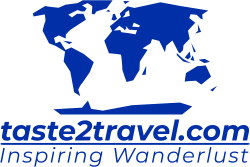Palau Travel Guide
Welcome to the taste2travel Palau Travel Guide!
Date Visited: February 2017 – March 2017
Introduction
There I was – on a dive, 20 metres below the surface of the Pacific Ocean, clinging to a large boulder that was firmly embedded in the seabed of the German channel. The current washing through the channel from the outgoing tide was strong but I was determined to keep my grip and await the arrival of a creature I had always dreamed of seeing up close. I would not be disappointed!
After some time a large shadow slowly loomed over me, blocking out the rays of the sun above, it was a large adult Manta Ray, a species which can grow to seven metres in width. It was soon joined by another – equally large – Manta Ray.
I was positioned at a cleaning station in the channel – the two giants floated two metres above me, being cleaned by an army of cleaner fish. To be so close to such magnificent creatures is an unforgettable experience – a highlight for any diver.

The Palau Ground Frog is endemic to Palau.
Diving is Palau’s main draw-card. The island nation is well known for its abundant marine life, anti-shark fishing policy and strict environmental regulations which apply inside the Palau National Marine Sanctuary – the world’s sixth largest sanctuary, covering an area twice the size of Mexico. At the centre of the sanctuary are the Rock Islands – 300 uninhabited limestone bumps surrounded by the most amazing turquoise water teeming with marine life.

The spectacular Rock Islands.
Source: http://www.allamazingplaces.com/rock-islands-palau/rock-islands-southern-lagoon-chelbacheb-palau-pacific/
Palau also has a fabulously rich, complex and unique culture – one which is still actively practiced. Colourful, traditional meeting houses, known as Bai’s, dot the landscape. Wooden carvings, known as ‘storyboards’, tell traditional folk stories.
All of this makes Palau an interesting and engaging destination for those willing to get off the beaten track. This remote, pristine Pacific island nation is not easy to reach – and – once there, is very expensive – but – it’s definitely worth the effort and cost.

Detail of a traditional Bai at the Belau National museum.
Location
Palau is located in the middle of the Western Pacific, about 1,600 km (1,000 miles) southwest of Guam and 1,000 km (600 miles) east of the Philippines.
History

Palau’s Capitol Building.
The first inhabitants of Palau arrived 3,000 years ago from the Philippines. The first Europeans to make contact with the islands were the Spanish in the 16th century – they made Palau a part of the Spanish East Indies in 1574. Following Spain’s defeat in the Spanish-American war in 1898, the islands were sold to German who administered them as part of German New Guinea. The Japanese captured Palau during WWI and occupied them until their defeat in WWII by the United States.

Traditional Palau ‘storyboard’ wood carving.
In 1947, Palau (along with the Northern Mariana Islands, Federated States of Micronesia and the Marshall Islands) was made part of the Trust Territory of the Pacific Islands, which was administered by the United States. In 1979 Palau voted against joining the newly independent Federated States of Micronesia, gaining full sovereignty in 1994 under a Compact of Free Association with the United States. The official currency of Palau is the US dollar.
Flag

The flag of Palau.
Introduced in 1981, the flag of Palau is wonderfully minimal but also strikingly beautiful. As with other Pacific island nations, the blue field represents the blue of the Pacific ocean while the yellow disk, which is slightly off-centre, represents the moon.
The Palauan’s consider the full moon to be the optimum time for human activity. At this time of the month, celebrations, fishing, sowing, harvesting, tree-felling, and the carving of traditional canoes are carried out. The moon is a symbol of peace, love, and tranquility.
Currency
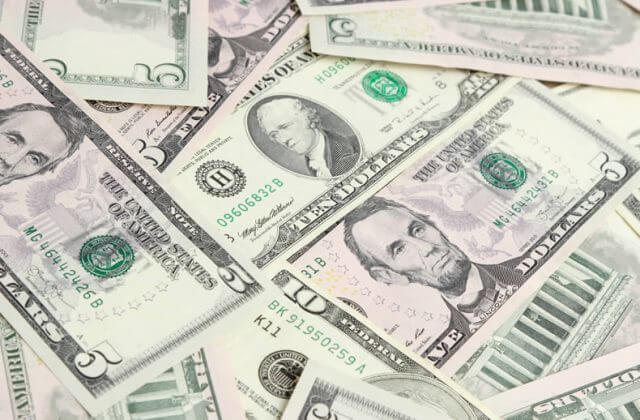
The US Dollar.
Being a former member of the US-administered Trust Territory of the Pacific Islands, the official currency of Palau is the US dollar.
Sights

Traditional Bai (meeting house) at Aimeliik.
Palau National Marine Sanctuary
The star attraction of Palau are the incredibly beautiful (World Heritage listed) Rock Islands – 300 (uninhabited) emerald-coloured, limestone/ coral mounds sprinkled throughout the stunningly picturesque turquoise-coloured southern lagoon between the islands of Koror and Peleliu.
As part of the Palau National Marine Sanctuary, this pristine, virgin environment is protected by a host of regulations. It’s here that you’ll find Palau’s most popular dive sites such as Blue Corner, Blue hole, German Channel and the famous Jellyfish lake – a lake that was home to thousands of sting-less jellyfish. At the time of my visit (March 2017), there were no jellyfish present in the lake so snorkeling trips were not being offered. Scientists believe droughts caused by El Niño may be to blame – you can read more about this in this National Geographic article.
I did two dives – one at German Channel and one at Blue Corner – with local dive operator Fish ‘n Fins. Like everything else on Palau, diving does not come cheap, with a two tank dive (including full equipment rental and a permit to the Marine Sanctuary) costing me almost $300. Prices do become more reasonable if you book multiple days of diving.
German Channel – named after the Germans who blasted a channel through the reef to facilitate transportation of phosphate into Koror – is famous for it’s Manta Ray cleaning stations. The stations are located at a depth of 20 m and on my dive we saw several of these huge, majestic creatures receiving a clean. The current can be quite strong during tidal movements but there are plenty of rocky outcrops to hold onto. The rock I used as my anchor was home to a beautiful octopus who kept sticking his head out of his hiding hole to see if I was still there. Between him and the Manta Rays it was a wonderful hour-long interaction.

Blue Corner – one of my dive sights on Palau.
Source: Kristine Barsky
Blue Corner is an underwater promontory sticking out of the reef like a triangular terrace twenty meters deep. Precipitous walls surround the terrace and are the favoured congregating ground for large schools of fish, including barracuda, jacks and lots of reef sharks. All of these schools attract plenty of predators and during our one hour dive I lost count of the number of sharks we saw. The abundance of marine life in this little corner of the Pacific is truly amazing.
Babeldaob
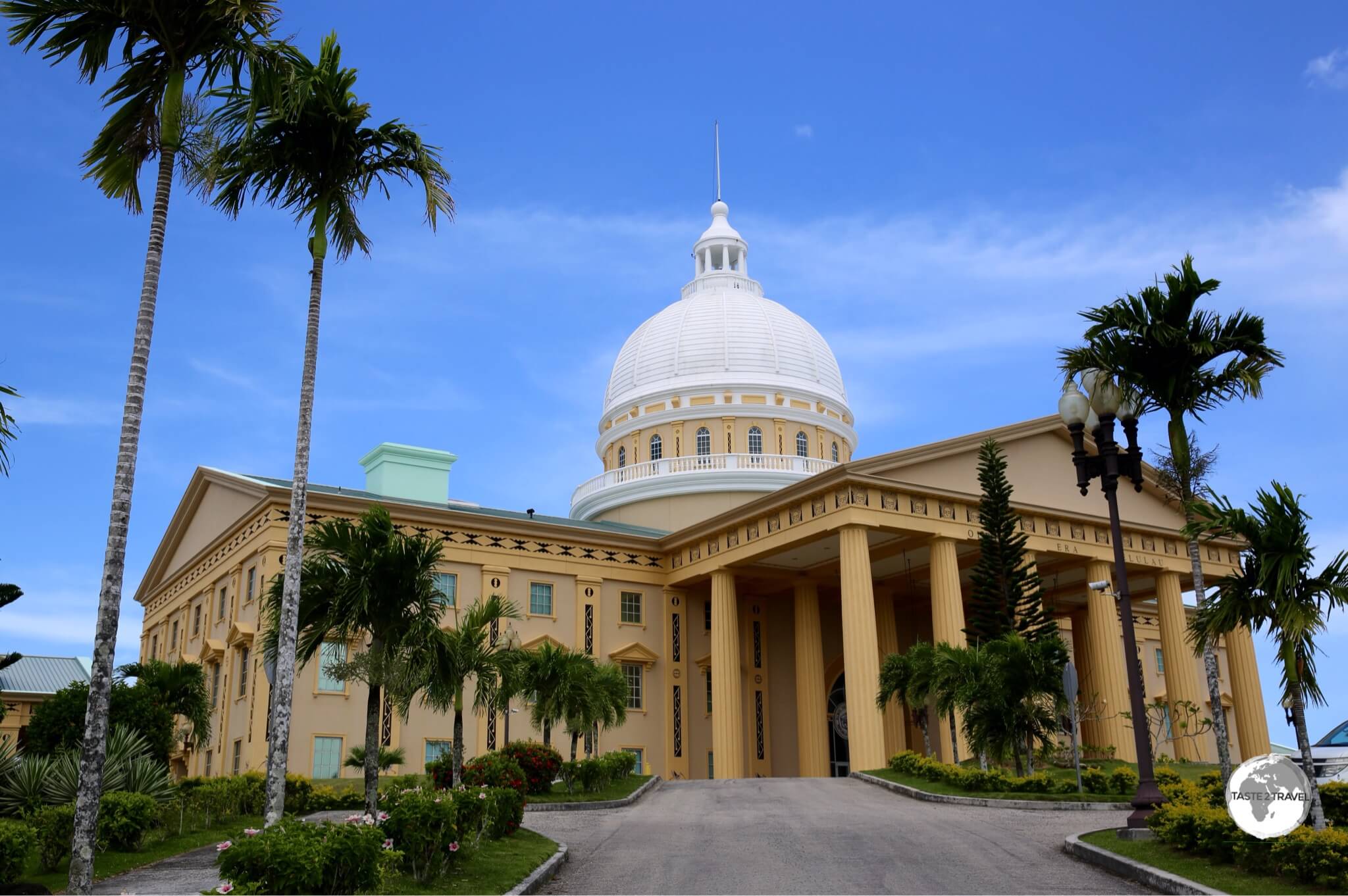
The Capitol Building at Ngerulmud, the tiny capital of Palau.
Back on land, I spent one day exploring the main (largest) island of Babeldaob in my rental car. Driving around the island is very pleasant thanks to the well-maintained, American-built Palau Compact road. The road circuits the island and can be easily driven in a few hours. Making stops at the various attractions along the way, you should allow half a day.
Babeldaob is home to Palau’s airport, it’s capital, Ngerulmud, and ten of the sixteen states. Each state on the island charges visitors an ‘entrance fee‘ to visit any sites within it’s boundaries. The fees can be up to $20 per person per state so it’s best to decide in advance which sites (and hence which states) you wish to visit. There are almost no restaurants on Babeldaob – the one place I was directed to was the wonderful seaside Okemii Deli & Internet Café in Melekeok. The café offers grilled local seafood along with other café staples.

Emerald tree skink at Papago International resort in Airai state.
The first state you enter after crossing the causeway from Koror to Babeldaob is Airai. Here you can decide to turn left onto the Palau Compact road and travel clock-wise around Babeldaob or turn right and travel anti-clockwise. Airai is home to the airport and several significant war ruins, including Kaigun Sho – a bombed Japanese communications centre. The state ‘entrance fee’ for visitors is $20 and eager government rangers are out in force patrolling sites to ensure tourists have paid their fee.
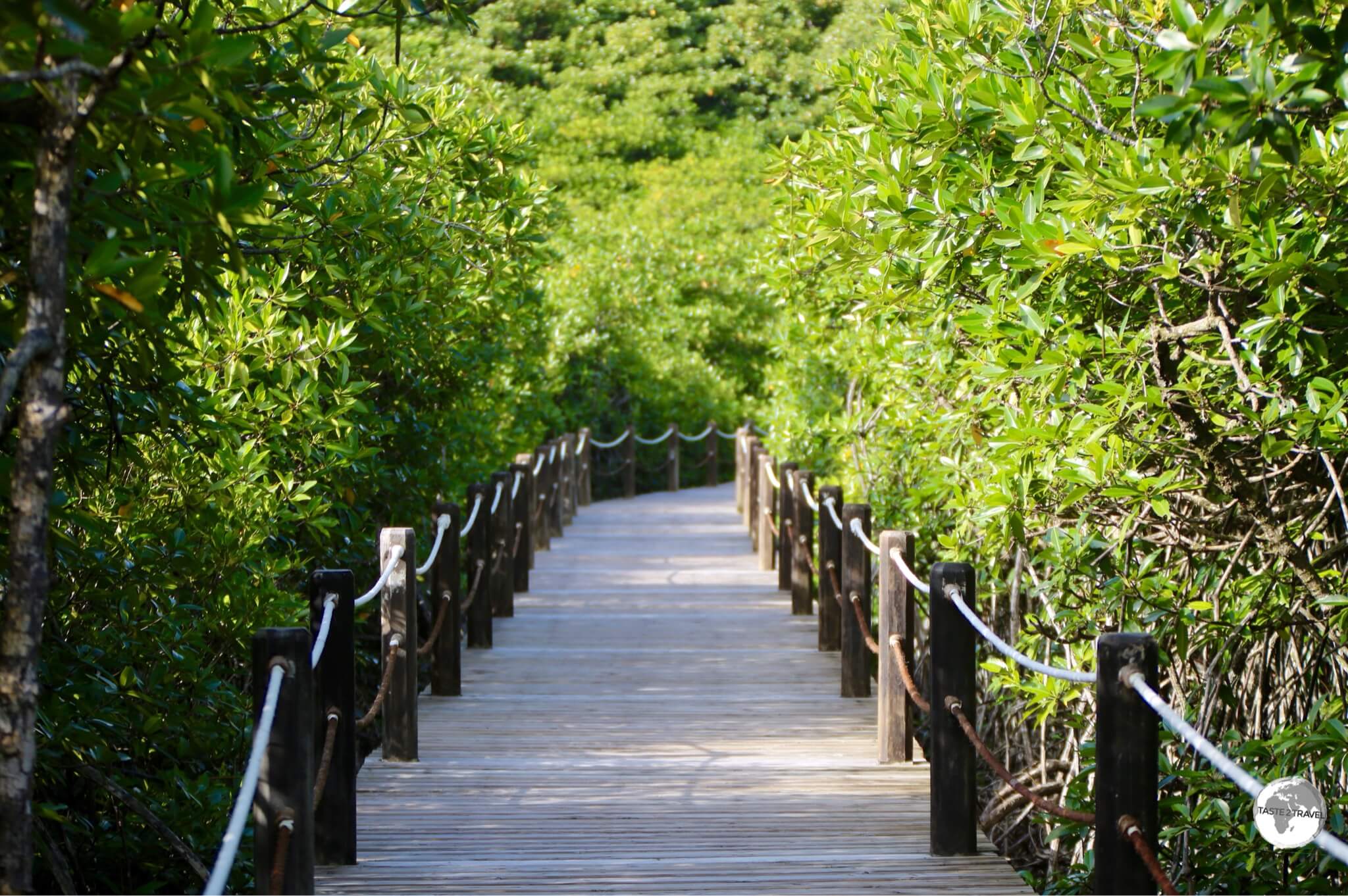
Mangrove walkway at Papago International Resort, Airai state.
One place worth visiting is the Mangrove walkway at the Papago International resort (5 minutes drive from the airport). For a small fee, visitors can access the resorts’ mangrove boardwalk. It’s a great place to spot birds and other wildlife.
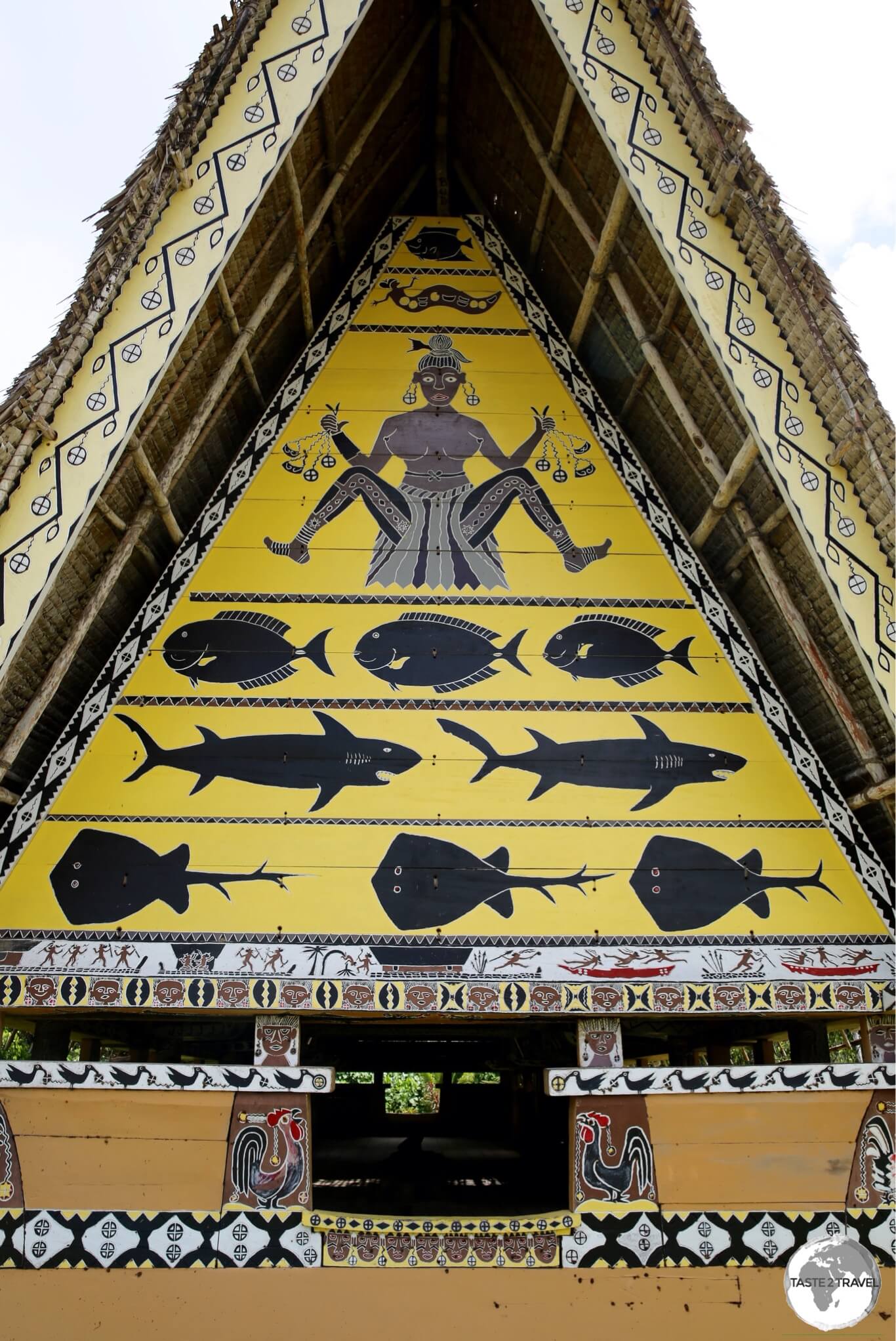
Detail of Aimeliik Bai.
Travelling in a clockwise direction around the island, the next state you enter is Aimeliik – home to one of the oldest villages in Palau and also home to a beautiful hilltop Bai.

Interior of the Aimeliik Bai.
The state ‘entrance fee’ for visitors is $10 and can be paid at the ticket office next to the Bai.

Bai at Aimeliik.
At the northern end of the island, you can visit Badrulchau monoliths – 37 basalt stone pillars (believed to be foundations from a building) from around 100 AD. Just south of the monoliths – on the north-east coast is the tiny state of Ngiwal (population – 220) – home to one coastal village with sandy beaches.

Low tide at Ngiwal state beach.
Continuing south you will eventually reach Melekeok state, home to the national capital enclave of Ngerulmud. With a population of just 270, Melekeok is the least-populous capital in the world.

The capital complex at Ngerulmud, a purpose-built capital.
The capital complex is very grand and impressive but not too interesting. You are not allowed to access any of the buildings (I did try to enter the Capital building and was promptly asked to leave by security) but you can wander around the grounds and take photos.
Okemii Deli & Internet Café is located on the beach downhill from the capital complex. There is (apparently) an impressive Bai in Melekeok state but this was closed for renovation at the time of my visit.

Capital buildings, Ngerulmud.
Koror
Koror is the centre of action on Palau. With 70% of the population and almost all tourists services, Koror is where visitors spend most of their time. This narrow, busy island is traversed by one long, main (permanently congested) road. Along this road are hotels, dive shops, banks, shops, cafes, bars, restaurants, government offices etc. The southern end of the island is home to upmarket resorts, built around quiet, pristine coves.

Traditional Bai at the Belau National museum in Koror.
Belau National Museum
There are two museums on Koror – the older Belau National museum (oldest museum in Micronesia) is home to a beautifully painted Bai and two floors of exhibits, which detail the complete history of Palau.

Detail of Bai at the Belau National Museum.
Etpison Museum
The newer Etpison Museum (named after a former president) is the place to come if you are looking for somewhere to develop a better understanding of Palau culture. The admission cost of $10 is a little steep for such a small museum – but this is Palau.

A display at the Etpison Museum in Koror.
Displays include; a model of a bai; local tools; artefacts; money; clothing; photos showing the childbirth ceremony and more. For Australians visiting the museum – you might be surprised to be greeted by two friendly sulphur-crested cockatoo’s that are kept in a cage inside the front door. Cockatoos were previously introduced to Palau from Australia.

Translucent turtle-shell bowls at the Etpison museum in Koror.
Story Board Wood Carvers

A ‘story board’ wood carver at his workshop in Koror.
If you’re impressed by the traditional ‘storyboard’ wood carvings displayed at the Etpison museum, you should ask staff for directions to the resident expert carver. His roadside studio is located in a side street a short walk north of the museum (turn left at the Blue Bay petrol station).

A Palau ‘story board’ wood carver in Koror.
Storyboards were introduced into Palau by a Japanese artist during the Japanese occupation of Palau and adapted by the islanders to record their own traditions. The stories that are told on the Palau storyboards are usually old Palau-an legends. You can watch the carvers at work and purchase directly from them (no bargains here).

A traditional Palau ‘story board’ wood carving.
Accommodation

The Hotel Palau Royal Resort.
Most hotels can be found on the island of Koror – a 30 minute drive from the airport. Like everything else on Palau – accommodation is not cheap. I stayed at the Japanese-owned DW Motel, which is located on the main road close to downtown. The first half of my stay coincided with their peak season, which meant I was charged $140 per night for my single room (definitely not worth the money but it was the cheapest place I could find). The second half of my stay was charged at $70 per night which was more reasonable but still over-priced. Breakfast is not included but you are provided with a clean, small, spartan (TV-less) room.
On the south side of the island are larger, more upmarket resorts. Many of the hotels on the island are Taiwanese-run and not registered on popular OTA (Online Travel Agent) sites such as booking.com
You should ensure you organise airport shuttle transfers in advance – do not assume taxi’s will be available at the airport when you arrive.
Eating Out
While traditional island cuisine is based on root vegetables, pork, chicken, and seafood – there has been enough outside influence (especially from America, Japan and – more recently – Taiwan) on the island that ensures local restaurants cater to a variety of tastes. Strung along the main road of Koror is a good selection of restaurants.
One of my favourite places is the fabulous Rock Island Cafe, an American-diner inspired restaurant staffed by friendly Filipino’s (they constitute the main labour force on the island). The cafe is open from early morning, offering possibly the best (and most reasonably priced) breakfast on the island. They have a bakery next door which supplies the cafe with amazing cakes which are sold very cheaply along with their freshly brewed coffees.
In the south, on the small island of Malakal is the Drop Off Bar and Grill. This outdoor, waterfront venue is perfect for sipping drinks and enjoying fresh local seafood and more.
Visa Requirements

Palau passport stamps.
Some visitors require visas to enter Palau, check your requirements prior to arrival.
Palau Entry Form
All passengers flying into Palau must submit the Palau Entry Form at most 72 hours before departure.
This will generate a QR code, which must be presented on a mobile device or printed copy during check-in and upon arrival.
Getting There
By Air
Airport
Flights to Palau arrive at Palau International Airport (IATA: ROR), also known as Roman Tmetuchl International Airport.
The airport is located 6-km north of Koror.
Airlines
The following airlines provide connections to/from Palau (Updated: August 2024):
- Air Niugini – flies to/ from Port Moresby, Tokyo–Narita (from 29 October 2024)
- Belau Air – flies to/ from Angaur, Peleliu
- Cambodia Angkor Air – flies to/ from Hong Kong, Phnom Penh
- Caroline Islands Air – flies to/ from Yap
- China Airlines – flies to/ from Taipei–Taoyuan
- Jeju Air – flies to/ from Seoul–Incheon
- Nauru Airlines Brisbane – flies to/ from Majuro, Nauru, Pohnpei, Tarawa
- Pacific Missionary Aviation – flies to/ from Angaur, Peleliu, Yap
- United Airlines – flies to/ from Guam, Manila
Departure Tax
Departure tax from Palau is a hefty $50 and is comprised of $25 terminal fee and $25 environmental fee.
Nauru Airlines

Nauru Airlines route map – as of August 2024.
Nauru Airlines offer regular connections to many destinations in the Central Pacific, including Palau, from their base at Brisbane International Airport.
An especially useful connection, for those already travelling in the South Pacific, is the airline’s regular flight from Nadi (Fiji) which offers connections to the Central Pacific.
Email address of the airline’s Brisbane office: book@ourtravel.com.au
Getting Around
Bus
There is no public transportation on Palau.
Taxi
Taxi’s are available around Koror – but almost non-existent elsewhere. It’s always best to book a taxi in advance rather than trying to hail one on the street. The fare from Koror to the airport is $25.
When I arrived at the airport (early evening flight from Guam) there were no taxis available. The friendly lady from the tourist information desk tried to arrange a taxi, but no drivers were willing to come out to the airport. She closed the information desk and drove me in her car to my hotel (providing me with a guided tour of the island along the way).
Car

Palau License Plates.
Hire cars are available, but like everything else on Palau – they’re not cheap. At the airport, Alamo quoted $70 a day for a compact car. I shopped around in Koror and found an old (compact) clunker which cost me $40 per day. Cars are often worn and old but the speed limit is 50 km/h and distances are not great.
Palau is divided into sixteen states (most states have just a few hundred residents) with each state having their own number plate.
That’s the end of my Palau Travel Guide.
Safe Travels!
Darren
Follow me on Instagram:
[instagram-feed feed=1]
Further Reading
Other travel reports from the Pacific region:
Palau Travel Guide Palau Travel Guide Palau Travel Guide Palau Travel Guide Palau Travel Guide Palau Travel Guide Palau Travel Guide Palau Travel Guide
Author: Darren McLean
Darren McLean is an Australian, full-time, digital nomad who has spent 37 years on a slow meander around the globe, visiting all seven continents, 192/ 193 UN countries and 245/ 251 UN+ countries and territories.
He founded taste2travel to pique one’s curiosity and inspire wanderlust.
